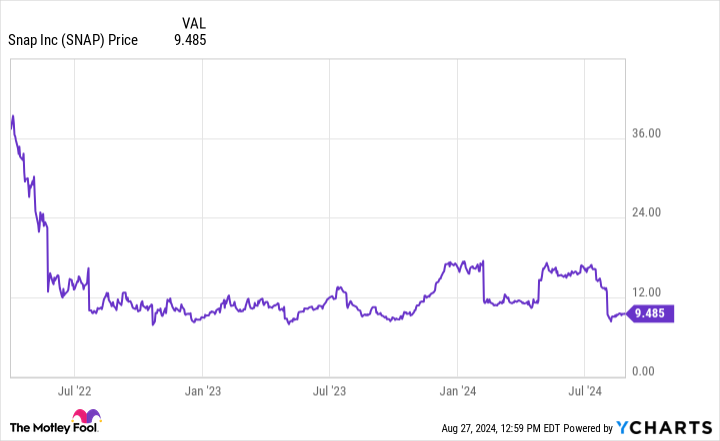My wrong call offers lessons for investors.
When it comes to investing mistakes, one of the costliest was underestimating the severity of the 2022 bear market. That led me to make bad bullish calls on some stocks that had lost more than half their value — and kept falling.
One of those stocks was Snap, Inc. (SNAP 1.30%). It had lost more than half of its value, and when it came to Snap stock in the next five years, I speculated that it would beat the S&P 500. Unfortunately, nearly 2.5 years later, the Snapchat parent has lost approximately 65% of its value since that time, making it unlikely to beat the market by April 2027.
Nonetheless, this lousy call on the social media stock offers lessons on investing in general, and on investing in Snap stock if I choose to do so.
What went wrong?
As for what went wrong, probably the biggest mistake was underestimating the severity of the 2022 bear market. When I made this call in April 2022, stocks were trending downward, but the belief seemed to be that it was a healthy pullback after a massive bull run in 2021. This led investors like myself to make calls on stocks down more than 50% and, unfortunately, on track to lose more.
Admittedly, investors can earn huge returns on big moves. However, in another sense, it makes investing more difficult amid the rising volatility.
As for Snap stock at the time, I thought it had turned a corner. After the industry behemoth Meta Platforms (META 0.60%) profited from copying Snap’s innovations, Snap learned to better leverage the power of advertising.
Additionally, Snap was gaining an increasing following with people over 25 years old, a necessary demographic to capture if it wanted to grow. Such improvements made me feel I could ignore ongoing losses and an approximate price-to-sales (P/S) ratio of 12.
Unfortunately, the 2022 bear market also led to a decline in advertising revenue. Since ad giants like Google’s parent Alphabet reported only single-digit increases in ad revenue at the time, it was unlikely that Snap would prosper in that environment, and indeed, the stock fell further.
Snap stock going forward
The question now is whether I would speculate that Snap stock will beat the market over the next five years beginning today. The truth is, I would not make such a claim now, and while such a surge is not impossible, it looks increasingly unlikely.
Snap stock continued falling in 2022, and by the low point of the bear market in late 2022, it had reached a price comparable to where it trades today.
Despite Snap’s lower price, I hesitate to make a bullish call, since its net losses continue to this day. Also, its $2.4 billion in revenue for the first half of 2024 is not far above the $2.2 billion in revenue it earned at the same point in 2022.
Considering the company’s relatively small market cap of $15 billion, it should grow more easily than Meta, which now claims a $1.3 trillion market cap. However, Meta grew its revenue 35% over the same two-year timeframe, compared to just 12% for Snap. That’s a factor that’s likely to deter growth investors from buying the stock.
Moreover, Snap should have a valuation edge, since its P/S ratio of 3 is close to all-time lows and far below Meta at 9 times sales. Nonetheless, the slower revenue growth and ongoing losses appear to negate that advantage.
Lessons on my Snap stock misstep
Ultimately, the wrong call I made on Snap and other stocks has changed how I look at investing in bull markets that are possibly turning negative. Probably the biggest lesson is that investors never know when a bottom will come. While I did not technically call a bottom on Snap in April 2022, I thought it was much closer than it actually was.
Second, I did not give enough thought to how Snap might perform in a severe downturn. I knew it had virtually no chance of unseating Meta in the social media space. Thus, I should have known it would see the negative effects of a downturn much faster and recover more slowly when conditions finally improved.
In fact, Snap’s stock price has yet to recover. For that and other reasons, I do not think it will beat the market over the next five years. Until it can accelerate its revenue growth, investors are likely best off taking speculative positions in this stock, if they choose to buy at all.
Randi Zuckerberg, a former director of market development and spokeswoman for Facebook and sister to Meta Platforms CEO Mark Zuckerberg, is a member of The Motley Fool’s board of directors. Suzanne Frey, an executive at Alphabet, is a member of The Motley Fool’s board of directors. Will Healy has no position in any of the stocks mentioned. The Motley Fool has positions in and recommends Alphabet and Meta Platforms. The Motley Fool has a disclosure policy.








